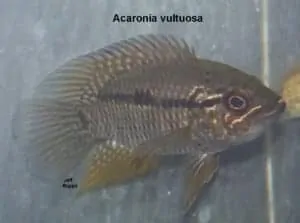Panamius panamensis
Panamius panamensis was first described in 1913 by Meek and Hildebrand. The genus name Panamius refers to Panama, the country where this genus occurs. The species name panamensis can be divided into two parts. The conjugation “ensis” indicates a place. The first part again refers to Panama.
The classification of the genus that this species falls into is somewhat problematic. It has moved several times in the past 30 years, from Neetroplus to Archocentrus and then to Cryptoheros. Currently, it is the only species in the genus Panamius. The question is whether this will remain the case or whether the species will be placed back in the Cryptoheros genus.
Description
This species can reach a maximum total length of about 13 centimeters. This makes it one of the smaller Central American cichlids. The females are somewhat smaller than the males.
The ground color is cream-white with a red color on top and blue dots in between. On the back, they have an olive green color that shows faintly between the colors. They often have black spots on the flank.
During the breeding period, the female changes color. The cream-white ground color remains but the red color disappears. Instead, they get gray spots which give them a gray appearance.
Character
They are quite spicy fish that are not afraid of other spicy or larger cichlids. The experiences of enthusiasts differ in this regard. Possible aggression also stems from the size and layout of the aquarium. Although Panamius panamensis don’t get too big, they do need their space. In any case, it is a species that shows itself and which you can therefore enjoy a lot.
Biotope
The habitat of Panamius panamensis is on the Atlantic side of Panama. They inhabit the zones with slow-flowing water above sand, gravel and rocks. Often there are also leaves on the bottom from the overhanging trees along the rivers and streams.
The type specimen was caught in the Rio Mandingo but they are also found in the Rio Chagres basin.
Diet
This cichlid is omnivorous. That means they need both animal and plant-based foods. You can feed them with frozen and live food, flakes, and granules. Make sure that there are also vegetable ingredients in the flakes or granulate or mix the flakes with some spirulina flakes.
They are voracious eaters, make sure they eat all the food within a few minutes. If it takes longer than 2 to 3 minutes or if food remains, you are feeding too much.
The aquarium
Because Panamius panamensis can show some aggression toward each other, they need an aquarium that is slightly larger than average. Think of a length of at least 120 centimeters. If you want to keep several specimens, you also need an even larger aquarium.
Set up the aquarium with sand or rounded gravel on the bottom. Place some rocks and/or wood for the fish to hide in between.
Plants are often dug up or pulled loose. You can keep plants, but then you have to protect the roots with some stones or secure Anubias, for example.
If you keep the temperature around 25 degrees Celsius, they usually do fine. In the wild, the temperature rises somewhat in the summer, towards 30 degrees Celsius. The pH may be between pH 7.0 and 8.0.
Spawning Tank and Conditioning
No special breeding aquarium is required for breeding with Panamius panamensis. They also reproduce in an aquarium with other fish species. Keep in mind that the aquarium must have enough space. An aquarium of one meter in length is not enough. If the nest is built in the center of the aquarium, they will chase the other fish deep into the corners.
They can reproduce when they are still quite small, even from about 2.5 centimeters in length. As with many substrate spawners, the first clutches can fail. The next nest usually follows soon after.
The spawn
When the Panamius panamensis female is ready to lay eggs, her color changes dramatically. The mottled red color then changes to a mottled black and white. The eggs are often laid sheltered in a cave.
The eggs are mainly fanned by the female. The male guards the territory. Once the eggs hatch, they both care for the newly hatched young. After a few days they can swim freely. After this, the female takes on almost all tasks. The male will certainly start looking for another partner in an aquarium with several females.
Raising the fry
The eggs hatch after a few days. The first few days they cannot yet swim and live on their egg yolk sac. After this, they are guided through the aquarium by the parents in search of food.
You can first feed the free-swimming Panamius panamensis fry with freshly hatched brine shrimp. If they have grown a little, also with finely crushed flake food. They are quite easy to raise.
Conclusion
Panamius panamensis is a very nice, not too big, Central American cichlid. They do have a strong character. This makes them less suitable for the beginner. If you have a little more experience in keeping fish, this is a fun challenge….if only the search for this hard-to-find species.
Video
Author
John de Lange
Copyright images
References





















Reviews
There are no reviews yet.